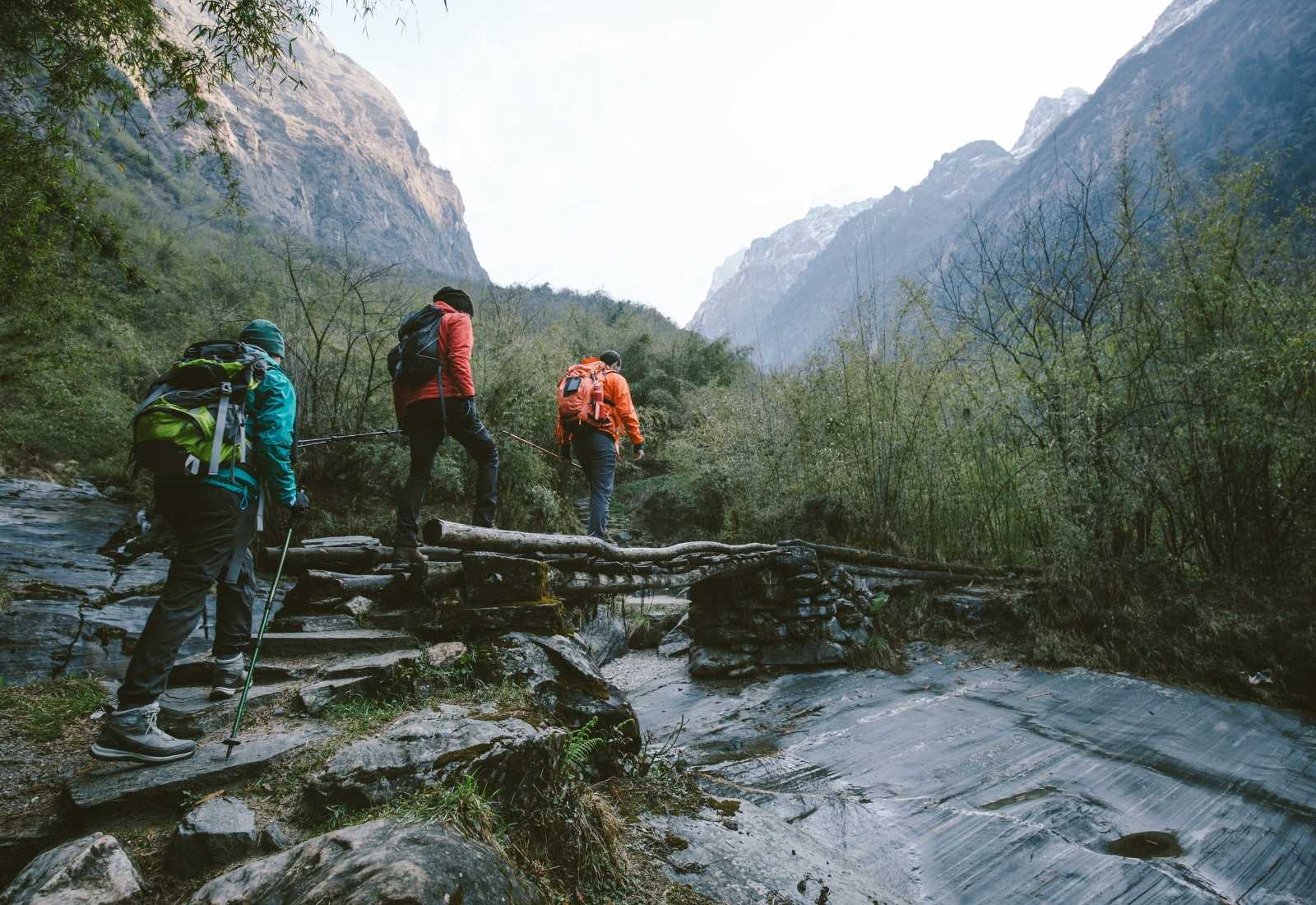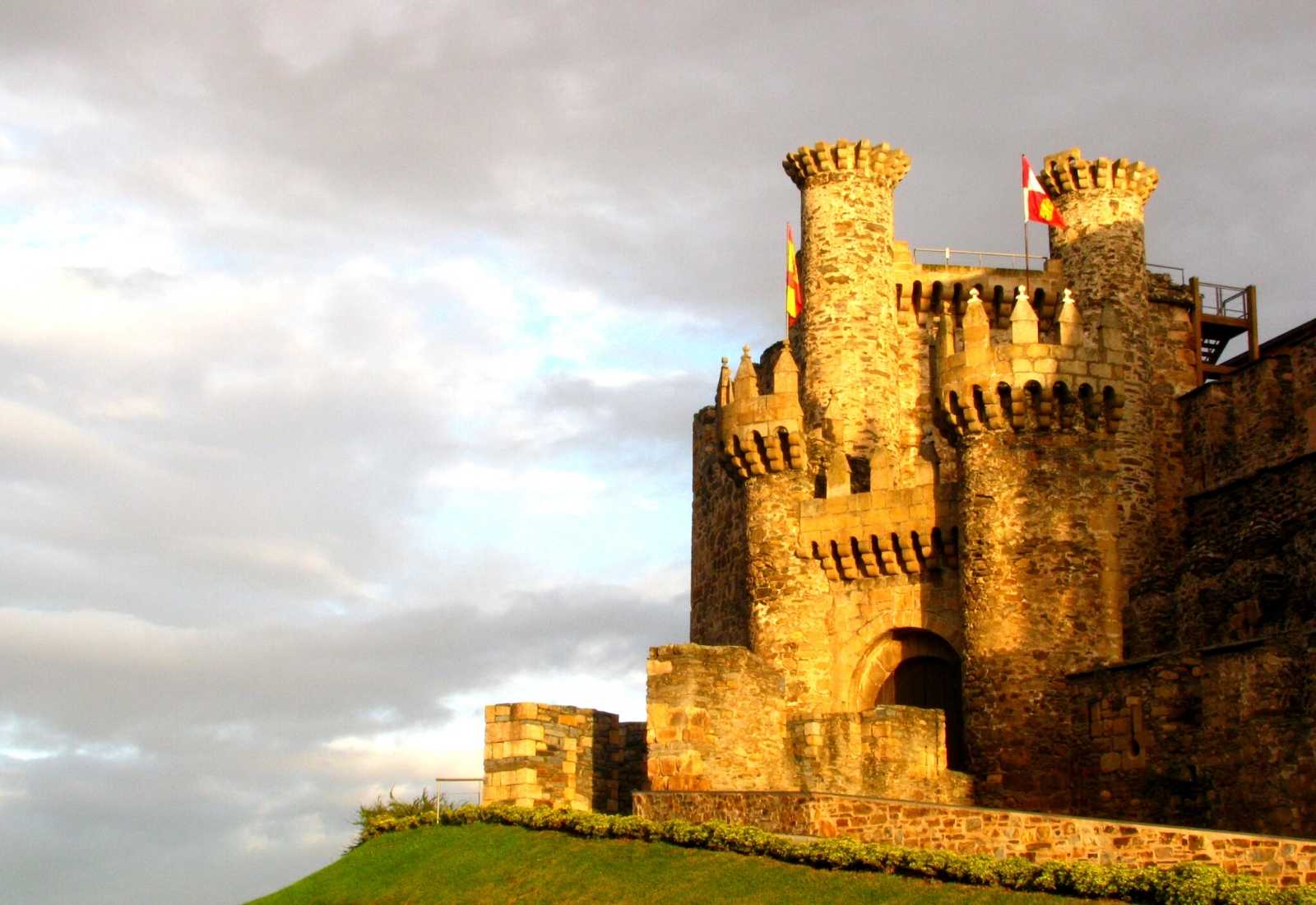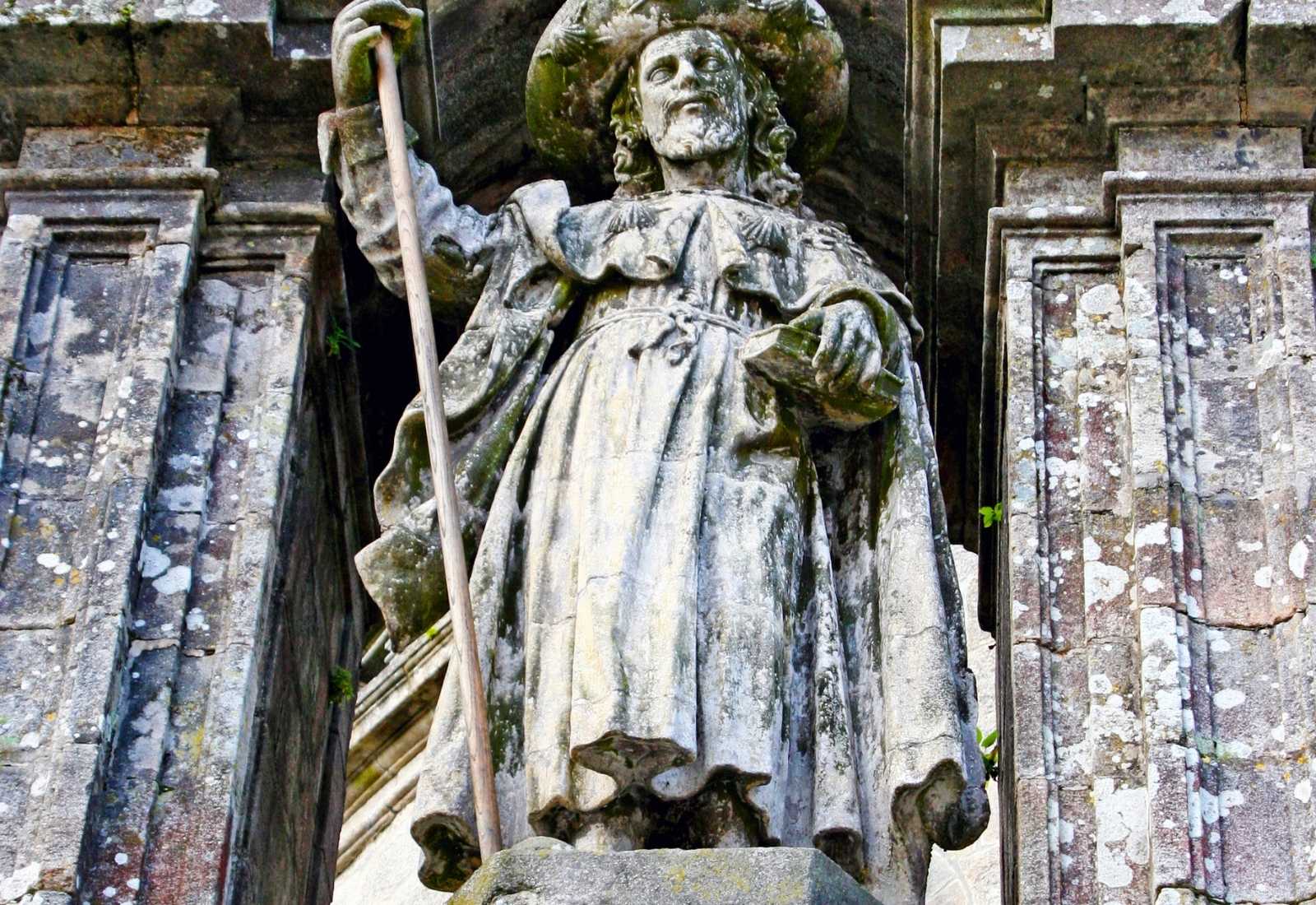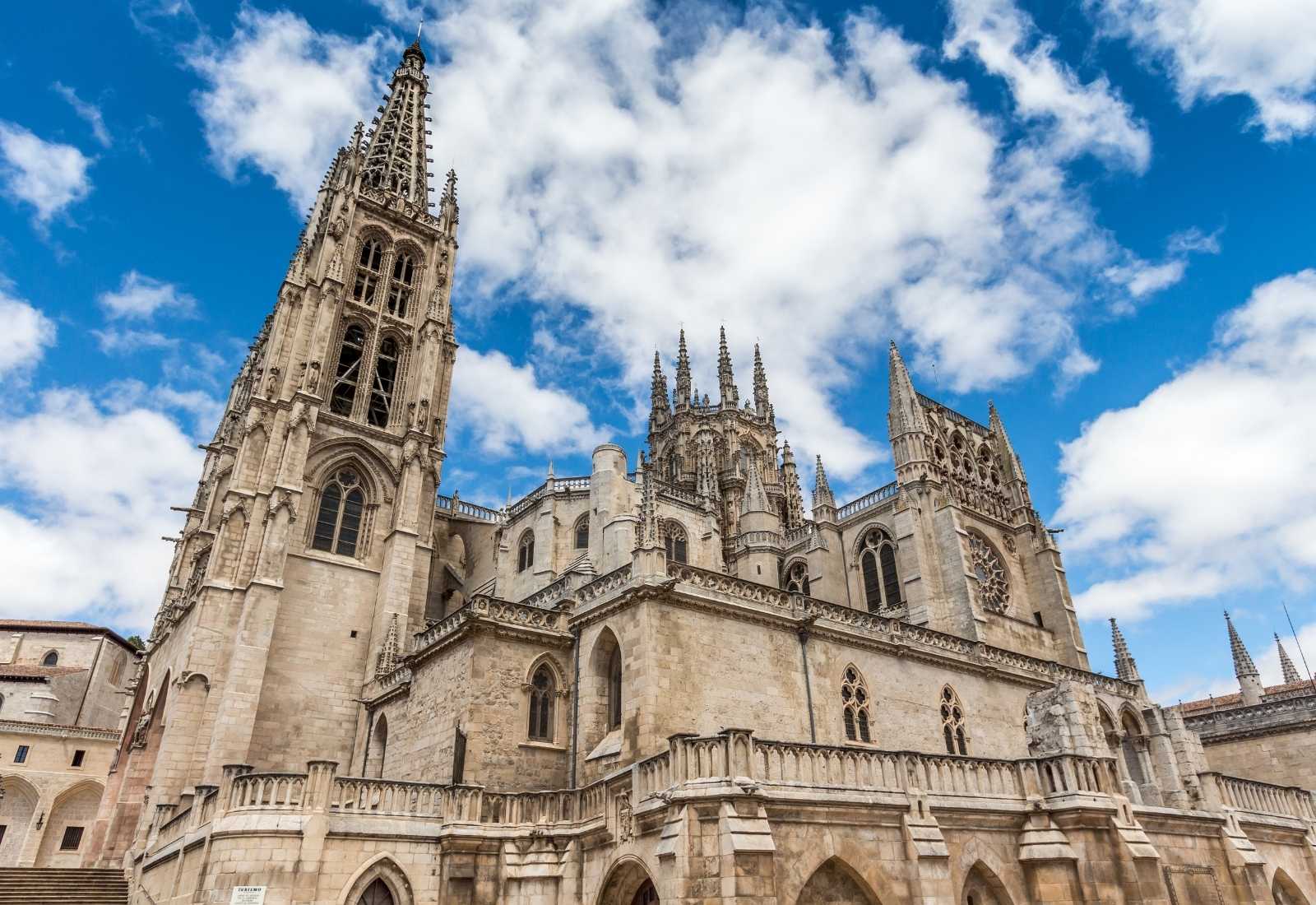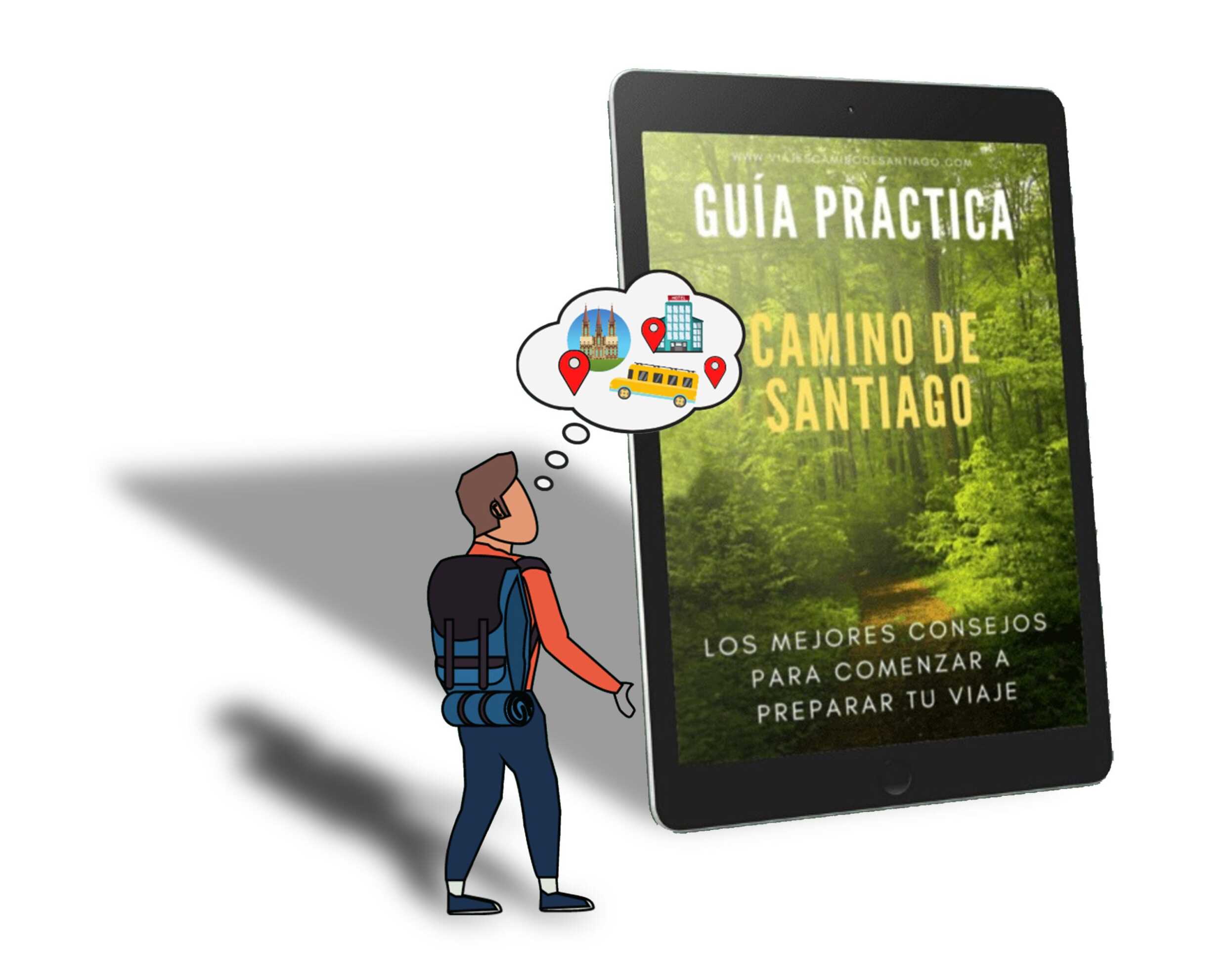The Camino de Santiago
Imagina un viaje que no solo te lleva a través de paisajes impresionantes, sino también a través de un conocimiento interior. El Camino de Santiago es una ruta milenaria que te ofrece precisamente eso.
Quédate con nosotros y te explicaremos las distintas alternativas que existen para llegar hasta el final de la experiencia: la Catedral de Santiago. Como sabrás, esta es una ruta de peregrinación milenaria cuya meta era llegar hasta la tumba del Apóstol. Por supuesto, había muchos caminos para llegar hasta aquí, senderos que aún hoy permanecen.
Gracias a la Ruta Xacobeas y a la Catedral de Santiago de Compostela, contenedora de reliquias y tesoros como el Botafumeiro o el Pórtico de la Gloria, nace la propia ciudad de Santiago de Compostela. Con la llegada de miles de peregrinos al templo apostólico para venerar las sagradas reliquias se fueron creando comunidades religiosas encargadas de su custodia. Asimismo, peregrinos y gentes fueron estableciéndose en la ciudad apostólica, construyendo poco a poco la hermosa ciudad que es hoy en día, el destino ansiado desde hace 1200 años por miles de peregrinos.
En camino a Compostela los peregrinos fueron forjando paso a paso y a través de los siglos las distintas rutas jacobeas, que en algunos momentos históricos llegaron casi a la desaparición total. Si el motivo principal para caminar a Santiago en la Edad Media era la expiación de culpas y redención del alma, hoy en día la peregrinación a Santiago ha adquirido un sentido más amplio.
Descubre el Camino de Santiago
Adéntrate en el fascinante mundo del Camino de Santiago, una red interconectada de rutas ancestrales. Estos caminos, trazados por siglos de peregrinaciones, te llevarán hacia el legendario sepulcro del Apóstol Santiago, un sitio de inmensa significación histórica y espiritual en la Catedral de Santiago de Compostela.
Al recorrer estas rutas, no solo emprenderás un viaje físico, sino también una profunda jornada de auto-descubrimiento y conexión espiritual.
La historia del Camino de Santiago
Para sumergirnos plenamente en la historia del Camino de Santiago, es esencial viajar en el tiempo, remontándonos a los albores del cristianismo. La historia comienza con Santiago el Mayor, cuya misión evangelizadora lo llevó a la Hispania Romana.
Es un viaje a través de la historia, un puente entre el pasado y el presente, que conecta a los peregrinos no solo con su fe, sino también con las raíces culturales y espirituales de Europa.
Santiago de Compostela: un tesoro de España
Santiago de Compostela es un testimonio viviente de la profunda herencia de España. Con raíces que se remontan a la época romana, esta ciudad ha sido testigo de momentos cruciales y ha sido un crisol de diversas civilizaciones, desde los misteriosos celtas hasta los guerreros suevos.
Pero el acontecimiento más trascendental en su historia fue, sin duda, el descubrimiento en el siglo IX del sepulcro del Apóstol Santiago, un hallazgo que transformó a esta ciudad en un epicentro de peregrinación y devoción cristiana.
La Catedral de Santiago: epicentro de peregrinación
La Catedral de Santiago, un majestuoso testimonio del arte románico español, se erige desde la Edad Media como uno de los destinos de peregrinación más venerados del mundo. Este impresionante monumento no es solo una obra maestra arquitectónica, es el corazón latente de las Rutas Jacobeas, un símbolo de fe y perseverancia.
No es solo un final de camino, sino un punto de encuentro donde historias, culturas y tradiciones se entrelazan.
Las Rutas del Camino de Santiago
Como imaginamos que ya sabes, el Camino de Santiago no es solo un sendero, sino un mosaico de rutas, cada una con su encanto único. Concretamente, nueve senderos principales te esperan, ofreciéndote una diversidad de paisajes: desde las verdes colinas de Galicia hasta los vastos campos de Castilla.
Explorar estas rutas significa sumergirse en experiencias variadas: Por ejemplo, el popular Camino Francés rebosa de historia y compañerismo, mientras que el sereno Camino del Norte ofrece una mirada más íntima y tranquila. Cada opción, con su propio clima y topografía, presenta un desafío diferente y una belleza única.
Indistintamente seas un peregrino experimentado o un aventurero primerizo, encontrarás que cada ruta es un viaje completamente distinto. No solo en kilometraje y afluencia, sino también en experiencias personales y espirituales.
A continuación, te vamos a hablar detalladamente de las rutas más populares del Camino de Santiago para que te hagas una idea de lo que te espera en cada una de ellas.
Camino Francés
El Camino Francés es sin duda la ruta más icónica y teje una experiencia inolvidable a lo largo de sus aproximadamente 800 kilómetros. Esta ruta, dividida en unas 33 etapas, es un viaje que invita a peregrinos de todas las edades y habilidades.
Conocida por su impresionante variedad de paisajes, desde los Pirineos hasta las llanuras de Castilla y los viñedos de La Rioja, es perfecta para quienes buscan un equilibrio entre aventura y comodidad. Su popularidad asegura una excelente infraestructura de albergues y servicios, lo que facilita la logística de tu peregrinaje.
Además, el clima en esta ruta es generalmente amigable, aunque variado, desde frescos inicios de montaña hasta el calor del verano en las mesetas. La amplia afluencia de peregrinos también significa una rica experiencia social, compartiendo historias y formando amistades. Si buscas una ruta clásica con un balance ideal entre desafío y disfrute, esta es tu elección ideal.
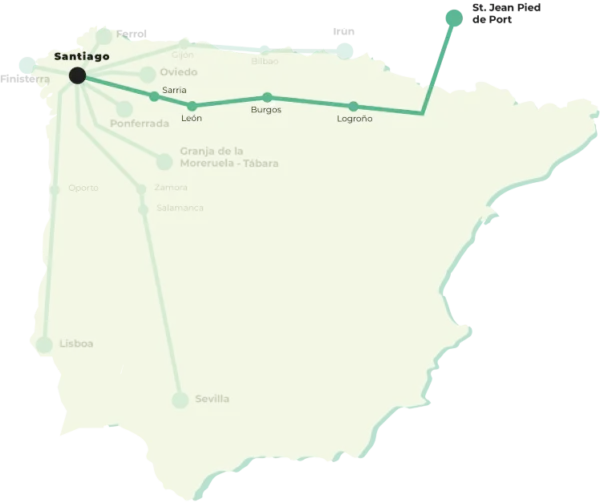
Desde Roncesvalles a Santiago de Compostela hay aproximadamente 800 km, que generalmente se dividen en unas 33 etapas, lo que se traduce en algo más de un mes caminando. En esta ruta el peregrino atraviesa la península de este a oeste a través de las Comunidades Autónomas de Aragón, Navarra, La Rioja, Castilla y León y Galicia, con una rica variedad de paisajes y culturas del norte de España.
Desde las verdes montañas navarras, pasando por la ancha meseta castellana y superando los montes que separan León y Galicia, el Camino Francés conduce al peregrino a Santiago de Compostela a través de caminos, puentes, pueblos y ciudades nacidas y construidas por y para el Camino de Santiago.
Mapa del Camino Francés
Los viajes más populares del Camino Francés
Camino Portugués
El Camino Portugués es una ruta histórica que sigue los pasos de peregrinos desde Lisboa hasta Santiago de Compostela y tiene una extensión de unos 620 kilómetros. Esta ruta se puede dividir en aproximadamente 27 etapas, cada una desvelando un paisaje cultural y natural único.
Aunque es menos transitado, a cambio ofrece una experiencia más íntima. Ideal para aquellos que buscan tranquilidad, reflexión y una oportunidad para sumergirse en la rica historia y cultura que une a España y Portugal. Además, la ruta presume de un clima suave, especialmente atractivo para quienes prefieren evitar los extremos de calor o frío.
Con un terreno generalmente llano y bien señalizado, esta ruta es accesible para peregrinos de diferentes niveles de experiencia y condición física. En este caso, la hospitalidad portuguesa y la belleza de las pequeñas aldeas y ciudades añaden un encanto especial al viaje.
Si lo que buscas es una combinación de retos moderados, riqueza cultural y serenidad, el Camino Portugués es una elección excepcional.
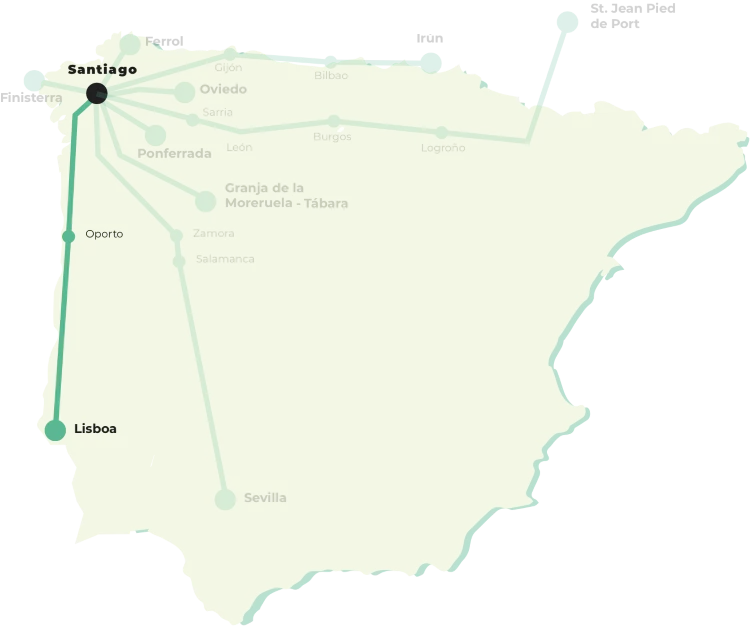
Desde Lisboa a Santiago de Compostela hay aproximadamente 620 km, divididos generalmente en unas 27 etapas, casi un mes caminando por el interior de Portugal. En sentido de sur a norte, el Camino Portugués atraviesa los distritos lusos de Lisboa, Santarém, Leiria, Coimbra, Aveiro, Porto, Braga y Viana do Castelo. Finalmente, cruza la frontera natural con España y Galicia a través del puente internacional sobre el río Miño para dirigirse a Santiago de Compostela.
Esta ruta no presenta grandes desniveles y ofrece casi todo el año temperaturas suaves. A través de ríos tan importantes como el Tajo, el Duero y el Miño, el peregrino llega a Santiago de Compostela tras disfrutar de una especial combinación de paisajes, monumentos y gastronomía de Portugal y Galicia.
Mapa del Camino Portugués
Los viajes más populares del Camino Portugués
Camino Portugués por la Costa
El Camino Portugués por la Costa es una variante más reciente y menos concurrida que su homólogo interior. Se extiende a lo largo de aproximadamente 280 kilómetros. Esta ruta costera, dividida en unas 12 etapas, ofrece una experiencia única, fusionando la serenidad del mar con el espíritu peregrino.
A diferencia de la opción anterior, esta ruta abraza el litoral atlántico, regalando paisajes marítimos y una brisa refrescante. Ideal para aquellos que buscan combinar su caminata con momentos de reflexión frente al océano. También para aquellos que buscan un refrescante baño en las playas que acompañan el trayecto..
Su terreno, aunque a veces irregular, es generalmente accesible, haciendo de esta ruta una opción atractiva tanto para peregrinos experimentados como para principiantes. Además, su relativa novedad significa que encontrarás menos multitudes, lo que permite una experiencia más personal y contemplativa.
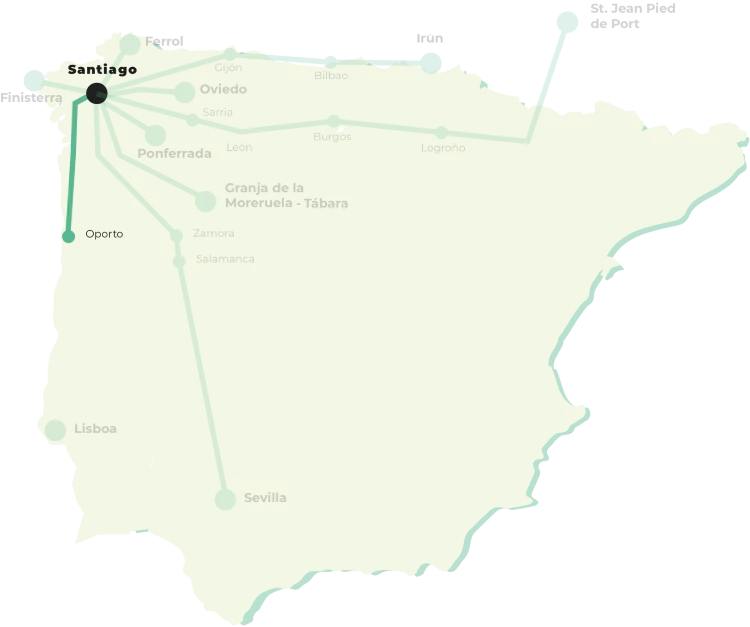
Desde Oporto a Santiago de Compostela hay aproximadamente 280 km, divididos generalmente en unas 12 etapas, unas dos semanas por la costa atlántica. En sentido de sur a norte, el Camino Portugués por la Costa atraviesa los distritos lusos de Porto, Braga y Viana do Castelo. Finalmente, cruza la frontera natural con España y Galicia en barco, navegando sobre el río Miño para dirigirse a Santiago de Compostela.
Esta ruta no presenta dificultad en cuanto a desniveles y ofrece casi todo el año temperaturas suaves. Con el océano Atlántico, pueblos pesqueros, playas y dunas como compañeros de ruta, este camino deja muy buen sabor de boca a todo peregrino que lo camina, y no sólo por las exquisitas gastronomías portuguesa y gallega.
Mapa del Camino Portugués por la Costa
Los viajes más populares del Camino Portugués por la Costa


Camino del Norte
El Camino del Norte es una ruta menos transitada pero inmensamente enriquecedora que se extiende a lo largo de unos 858 kilómetros. Esta opción, que se puede dividir en alrededor de 35 etapas, serpentea a lo largo de la costa norte de España, ofreciendo inmejorables vistas del Mar Cantábrico y paisajes verdes.
A diferencia de otras rutas más populares, el Camino del Norte brinda una experiencia mucho más solitaria y reflexiva. Es ideal para aquellos que buscan un retiro espiritual en medio de la naturaleza. Su trayecto, que recorre antiguas vías romanas y medievales, sigue impregnado de historia y cultura.
El terreno variado incluye tanto costas como montañas y presenta un desafío físico mayor, lo que lo hace especialmente atractivo para peregrinos experimentados. El clima, más fresco y húmedo, es una bendición durante los calurosos meses de verano.
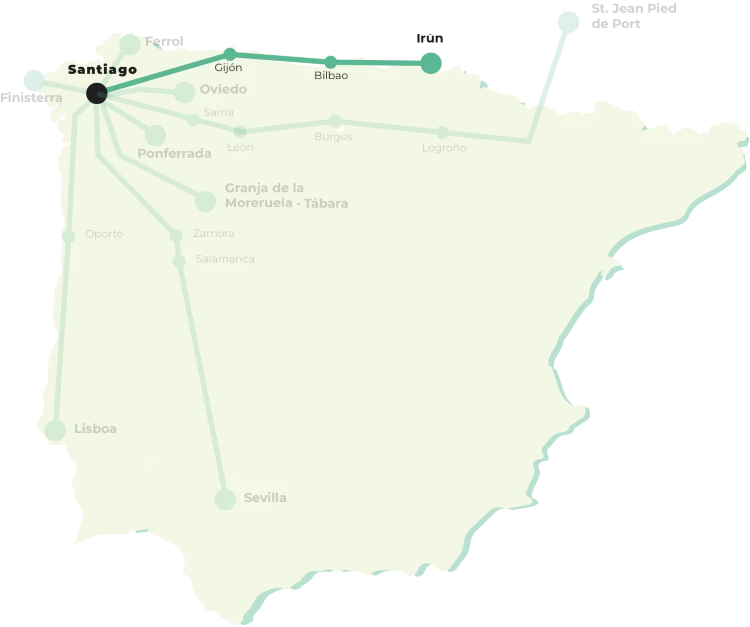
Desde Irún a Santiago de Compostela hay aproximadamente 858 km, que generalmente se realizan en unas 35 etapas, más de un mes caminando. En esta ruta el peregrino recorre la península de este a oeste en paralelo al mar Cantábrico, atravesando las Comunidades Autónomas de Euskadi, Cantabria, Asturias y Galicia.
Con la brisa cantábrica y el verde norteño, el Camino del Norte permite disfrutar de hermosos paisajes de mar y montaña, así como toda la cultura de los pueblos marineros del mar Cantábrico y su exquisita gastronomía. En Arzúa, esta ruta confluye con el Camino Francés.
Mapa del Camino del Norte
Los viajes más populares del Camino del Norte




Camino Primitivo
El Camino Primitivo está considerado como el más antiguo de los Caminos de Santiago, de ahí su nombre. Ofrece una travesía de aproximadamente 320 kilómetros. Compuesto por unas 14 etapas, es una fusión perfecta de desafío y belleza, llevando a los peregrinos a través de paisajes asturianos y gallegos.
Menos transitado que el Francés o el Norte, garantiza una experiencia más íntima y tranquila. Su historia se remonta al siglo IX, cuando el rey Alfonso II el Casto peregrinó desde Oviedo hasta Santiago, estableciendo esta ruta. Hoy, es un trayecto que invita a la reflexión y a la introspección.
Conocido por su terreno montañoso y senderos a través de densos bosques, presenta un reto para aquellos que buscan más que un simple paseo. El clima, húmedo y variable, añade a su desafío y encanto.
También es ideal para peregrinos que necesiten una experiencia más solitaria, en contacto directo con la naturaleza y la historia. Esta elección espera a quienes desean seguir los pasos de los primeros valientes que alcanzaron tal proeza.
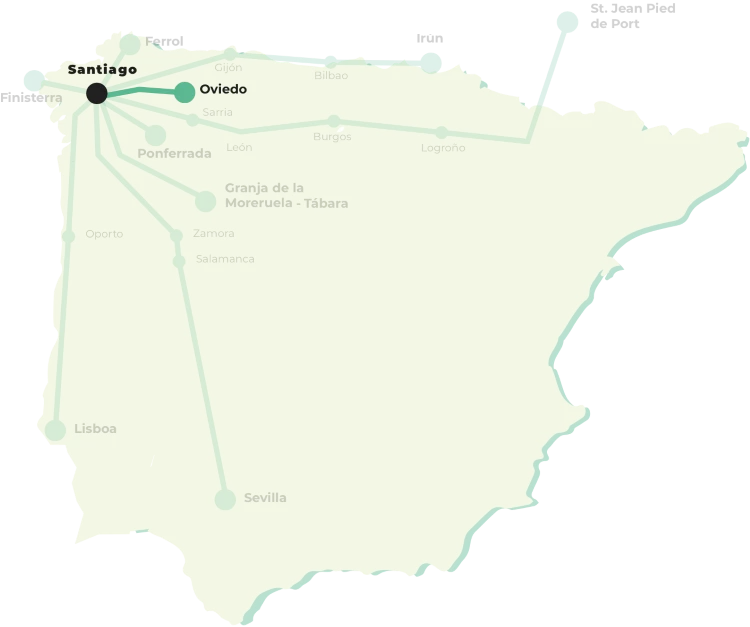
Desde Oviedo a Santiago de Compostela hay aproximadamente 320 km divididos en unas 14 etapas. En esta ruta el peregrino recorre las Comunidades Autónomas de Asturias y Galicia de este a oeste, partiendo del occidente asturiano y en dirección al sepulcro apostólico.
Esta es una ruta muy exigente en sus primeras etapas de montaña entre Asturias y Galicia. Una vez superadas, el camino se vuelve amable y discurre por las verdes colinas y campos gallegos. En la ciudad de Melide esta ruta alcanza el Camino Francés, y junto a él llegan a Santiago de Compostela.
Mapa del Camino Primitivo
Los viajes más populares del Camino Primitivo
Camino Inglés
El Camino Inglés es una ruta histórica que atraía principalmente a peregrinos del norte de Europa, se extiende por unos 113 kilómetros. Con tan solo 5 etapas, es una opción ideal para quienes disponen de menos tiempo pero desean vivir la experiencia completa del Camino de Santiago.
A diferencia de rutas más largas, ofrece una aventura compacta e igualmente rica en historia. Durante la Edad Media, era la elección principal de los peregrinos que llegaban por mar desde Inglaterra y otros países nórdicos. Hoy, sigue siendo un testigo silencioso de esos viajes ancestrales.
Esta ruta, que empieza en Ferrol o A Coruña, es perfecta para quienes buscan una experiencia de peregrinación más tranquila y menos concurrida.
A pesar de su corta distancia, no escatima en belleza, ofreciendo paisajes verdes y costeros característicos de Galicia. Con un terreno variado pero no excesivamente desafiante, es ideal tanto para principiantes como para peregrinos experimentados que buscan una nueva perspectiva de la aventura.
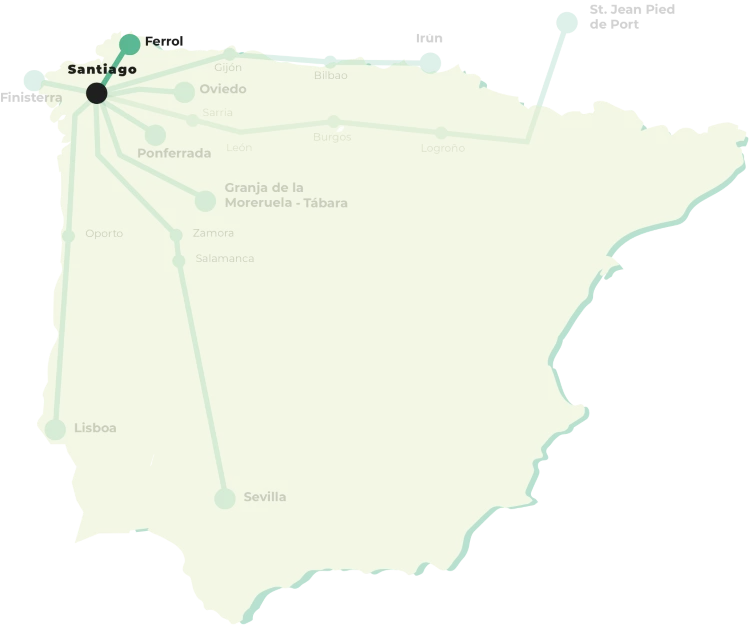
Desde A Coruña a Santiago de Compostela hay aproximadamente 74 km divididos en unas 4 etapas, mientras que desde Ferrol a Santiago de Compostela hay 113 km divididos en 5 etapas. Esta ruta es muy particular, pues solo recorre la provincia gallega de A Coruña, de norte a sur, en todo su recorrido.
Esta es una ruta que transcurre cerca del mar en sus primeras etapas. No presenta un desnivel exigente, y permite descubrir el paisaje y patrimonio de las Rías Altas gallegas, al mismo tiempo que ofrece una estupenda gastronomía donde el protagonista es el mar.
Mapa del Camino Inglés
Los viajes más populares del Camino Inglés
Camino de Finisterre y Muxía
El Camino de Finisterre y Muxía, único en el mundo del peregrinaje, no termina en Santiago, sino que continúa hasta el “fin del mundo”. Abarcando unos 90 kilómetros hasta Finisterre y unos 30 kilómetros adicionales si se extiende hasta Muxía, esta ruta se puede completar en aproximadamente en 4 o 5 etapas.
Tradicionalmente, se recorría después de llegar a Santiago de Compostela, como una forma de culminar el viaje espiritual frente al mar infinito. Hoy, sigue atrayendo a aquellos que buscan un cierre simbólico de su peregrinación, ofreciendo momentos de profunda reflexión y paz.
Con su recorrido que serpentea a lo largo de la costa, ofrece vistas espectaculares del Atlántico. A pesar de ser menos conocido, ofrece la oportunidad de experimentar la tranquilidad y belleza de las aldeas y paisajes gallegos, lejos de las multitudes de las rutas más populares.
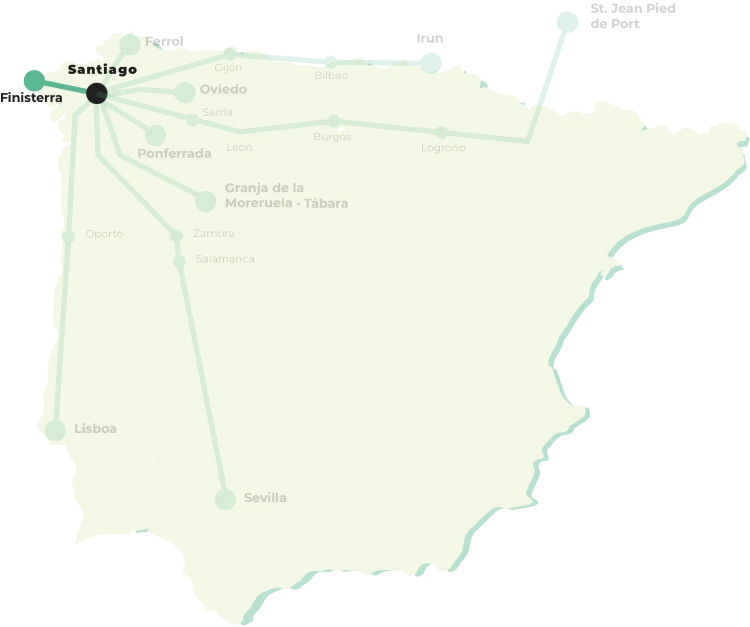
No es una ruta muy exigente en cuanto a desnivel. En ella el peregrino descubrirá el rural gallego salpicado de muchísima arquitectura tradicional, paisajes verdes y lugares de leyenda. Como celebración final, no puede faltar una foto en el kilómetro 0 de todos los caminos jacobeos.
Mapa del Camino de Finisterre y Muxía
Los viajes más populares del Camino de Finisterre y Muxía
Vía de la Plata
La Vía de la Plata es una de las rutas más largas y menos transitadas, se extiende por unos impresionantes 1000 kilómetros. Este antiguo camino romano, transformado en ruta de peregrinación, está dividido en aproximadamente 38 etapas. Atraviesa la diversa geografía española desde Sevilla hasta Santiago.
Es un viaje a través de la historia, empezando en el sur de España y pasando por antiguas ciudades romanas y moriscas. Su longitud y la variedad de sus paisajes la hacen maravillosa para los peregrinos experimentados que buscan una experiencia de inmersión total y menos comercial.
Además de su riqueza histórica, ofrece una diversidad de climas y terrenos, desde las suaves colinas de Extremadura hasta las verdes montañas de Galicia. Con una afluencia menor de peregrinos, es perfecta para aquellos que buscan soledad y un desafío personal.
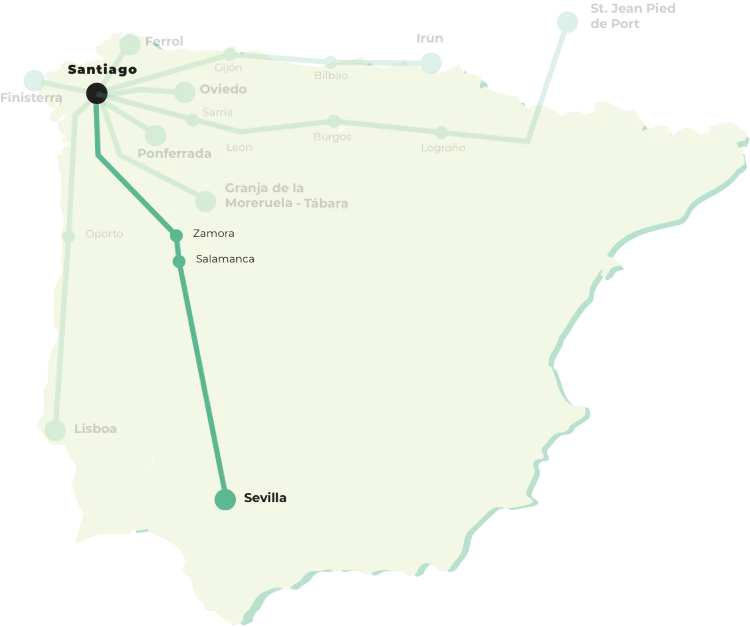
Desde Sevilla a Santiago de Compostela, a través de la Vía de la Plata y el Camino Sanabrés, hay casi 1000 km divididos en unas 38 etapas. En esta ruta el peregrino recorre las Comunidades Autónomas de Andalucía, Extremadura, Castilla y León y Galicia de sur a norte.
Esta es una ruta poco exigente en cuanto a relieve. Combinando los paisajes de olivares del sur de España y el verde propio de Galicia, esta ruta ofrece un impresionante patrimonio romano y la diversa riqueza gastronómica de la península Ibérica.
Mapa de la Vía de la Plata
Los viajes más populares de la Vía de la Plata




Camino de Invierno
El Camino de Invierno, una ruta alternativa y menos conocida, ofrece un viaje de aproximadamente 253 kilómetros. Con unas 10 etapas, esta ruta fue históricamente elegida por peregrinos que buscaban evitar las montañas nevadas del Camino Francés durante los meses de invierno.
Atravesando la región vinícola de Ribeira Sacra y pasando por antiguos monasterios, es una elección perfecta para los amantes de la historia, la cultura y la naturaleza. A diferencia de otras rutas más populares, ofrece una experiencia de peregrinaje tranquila y meditativa.
Su terreno variado, que combina colinas y valles, supone un reto moderado, adecuado tanto para peregrinos experimentados como para aquellos que buscan una alternativa más tranquila. Con una baja afluencia de peregrinos, es ideal para una experiencia más personal y reflexiva, sumergiéndose en la belleza silenciosa de la España interior.
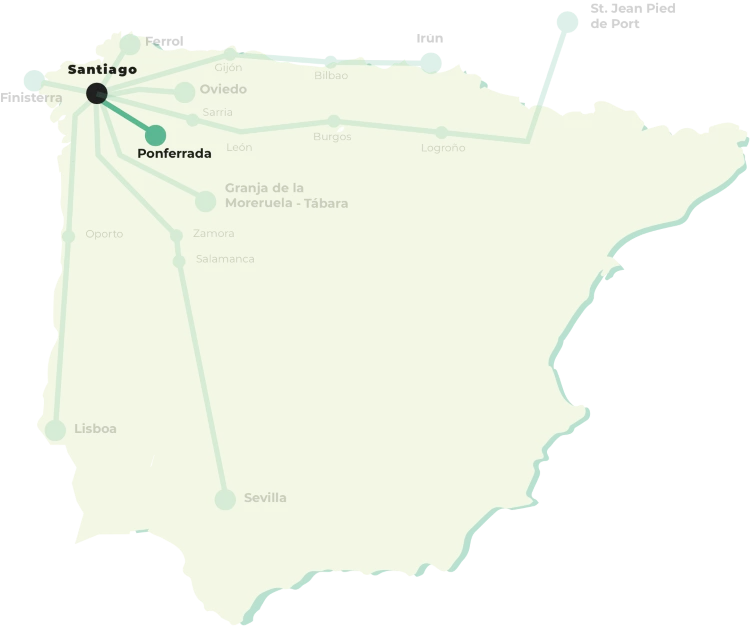
Desde Ponferrada a Santiago de Compostela hay aproximadamente 253 km a realizar en unas 10 etapas. Esta ruta recorre el noroeste peninsular de este a oeste a través de las Comunidades Autónomas de Castilla y León y Galicia.
Los hermosos paisajes de El Bierzo leonés y los cañones del río Sil lucense animarán al peregrino en esta ruta algo desconocida, que ofrece inspiradores paisajes, un rico patrimonio y una gastronomía que invita a ser degustada con algunos de los mejores vinos de Galicia.
Mapa del Camino de Invierno
Los viajes más populares del Camino de Invierno
Artículos relaccionados con el Camino de Santiago
Preguntas de interés
The Camino de Santiago in Galicia can be started from various points depending on the chosen route. Galicia is the final stretch of all pilgrimage routes, and here we list some of the most popular starting points for the main routes that cross Galicia:
- Sarria: French Way.
- O Cebreiro: French Way (border with León).
- Tui: Portuguese Way (border with Portugal).
- A Guarda: Portuguese Way of the Coast (border with Portugal).
- Ferrol: English Way.
- Ourense: Sanabrés Way.
- A Canda: Sanabrés Way (border with Zamora).
- Ribadeo: Northern Way (border with Asturias).
- Lugo: Primitive Way.
- O Acevo: Primitive Way (border with Asturias).
- Santiago de Compostela: Way to Finisterre and Muxía.
The Camino de Santiago is generally safe, but walking at night is not recommended. The routes are often poorly lit, which increases the risk of accidents, disorientation or encountering animals in the wild. In addition, all services will be closed.
Most, if not all, pilgrims rest during the night. For a safer experience, it is best to walk during the day and plan your arrival at accommodation before dark.
For the Camino de Santiago, make sure to pack weather-appropriate clothing, including quick-drying pants, a technical t-shirt, a sweatshirt, and suitable footwear.
Also, bring a sleeping bag for hostels, extra clothes, waterproof layers, comfortable shoes for resting, toiletries, sunscreen, a basic first aid kit, your phone charger, an extra battery, important documents like your health card, and the pilgrim’s credential. Keep your backpack weight under 10% of your body weight.
On the Camino de Santiago, you have the flexibility to choose from a range of accommodations, including private hostels, budget-friendly options like hostels and pensions, hotels, rural houses, and even luxury hotels. We also offer pet-friendly accommodations, ensuring that your furry companions are welcome along your journey.
We always emphasize that embarking on the Camino de Santiago alone is one of the most enriching ways to fully immerse yourself in the experience. Living the experience alone is a challenge that can be truly rewarding. While there may be moments when you feel alone, you’ll ultimately find gratitude in the solitude.
They say that the Camino de Santiago acts as the best form of therapy. It allows you to disconnect and dedicate time to what really matters. Reflect on your worries, clarify your thoughts, and begin your journey with the simple task of following the yellow arrows.
Plus, you will never truly be alone. This becomes evident once you set foot on the Camino. Along the stages, you’ll encounter numerous pilgrims with whom you will soon start conversations, share trails, accommodation, tables on terraces, and endless experiences that you will remember with nostalgia when you return home.
First of all, it’s important to understand that embarking on the Camino de Santiago doesn’t require being an elite athlete or being accustomed to long daily walking. It’s an achievable journey for everyone, including you.
If you are considering this trip and you are not sure about your physical condition, don’t worry. You are going to walk an average of 20 kilometers a day. If you find yourself unable to do so, you have two options: start training, do shorter stages, or join an organized group trip which has a support vehicle.
If you’re interested in training but unsure where to start, we recommend checking out our article on Training for the Camino de Santiago.
As you know, there isn’t just one route for the Camino de Santiago, and moreover, there’s no obligation to complete it within a set timeframe. To qualify for the Compostela, the minimum distance required is 100 kilometers on foot or 200 kilometers if traveling by bike. In both cases, allowing at least one week should suffice to complete the journey in stages of 20 kilometers per day for walkers or 50 kilometers per day for cyclists.
The Camino de Santiago can be done at any time of the year, each season offering a unique experience.
High season: From the beginning of May to mid-October, this period sees warmer temperatures and a higher number of pilgrims, especially along popular routes like the French or Portuguese Camino. It’s ideal for those seeking to immerse themselves in the bustling pilgrim atmosphere and make new connections. If traveling during this time, we recommend booking accommodations in advance or exploring less crowded routes.
Low season: It includes almost the whole winter, from November to the end of February or early March, , the low season experiences minimal pilgrim traffic due to inclement weather, with many accommodations and services closed. If embarking on the Camino during this period, thorough itinerary planning and advance reservations are advisable.
Mid season: Encompassing the remaining months of the year, many consider this the optimal time for the Camino de Santiago. With mild temperatures, autumnal landscapes, and fewer crowds compared to the summer months, it’s a delightful period to savor the sensory experiences of the journey.
To receive your Compostela, upon arrival in Santiago, you’ll need to visit the Oficina del Peregrino, situated at Calle Carretas, nº 33.
To obtain the Compostela, you must fulfill three requirements:
- Undertake the Camino de Santiago for religious or spiritual reasons, or at least with a sense of seeking.
- Complete the last 100 km of any of the routes on foot or on horseback, or the last 200 km by bicycle until reaching Santiago.
- Collect stamps along the way on your Pilgrim’s Credential. While stamps from churches, hostels, monasteries, cathedrals, and other Camino-related sites are preferred, stamps from accommodations, businesses, town halls, bars, etc., will also be accepted. Your Credential should be stamped at least twice daily.

